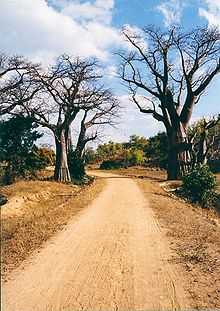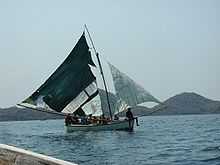Likoma Island
|
St. Peter's cathedral in Likoma town | |
 Likoma Island (Malawi) | |
| Geography | |
|---|---|
| Location | Lake Malawi |
| Archipelago | Likoma Islands |
| Total islands | 2 |
| Major islands | Likoma, Chizumulu Island |
| Area | 18 km2 (6.9 sq mi) |
| Country | |
|
Malawi | |
| Region | Northern Region |
| District | Likoma |
| Largest settlement | Likoma |
| Demographics | |
| Population | 9,000 |
| Density | 500 /km2 (1,300 /sq mi) |
Likoma Island is the larger of two inhabited islands in Lake Malawi (also known as Lake Nyasa), in East Africa, the smaller being the nearby Chizumulu. Likoma and Chizumulu both belong to Malawi, and together they make up the Likoma District. Although both islands lie just a few kilometres from Mozambique, and are entirely surrounded by Mozambican territorial waters, they are both exclaves of Malawi.
Geography
The island has an overall area of 18 km², and is located in the north-eastern part of Lake Malawi, 7 km north-west of Cobue, Mozambique). The closest city on the Malawian coast is Chintheche.
History
In 1880 missionaries from the Universities' Mission to Central Africa, founded in response to a plea by David Livingstone, established their headquarters on Likoma Island. Due to Livingstone's built headquarters, the island was assigned to Malawi rather than Mozambique when national borders in East Africa were established after World War II.
Natural environment
Despite a high population density, the natural environment of Likoma island is largely unspoiled. The coast is varied, with rocky slopes, sandy bays and swamps. The interior of the island is mostly covered by grassland, with a large number of baobab trees (of the Adansonia digitata species) and mango trees. Fauna is mostly composed of small reptilians, amphibians, birds and a number of invertebrates, including scorpion spiders. On the coast, crocodiles are occasionally seen. The waters around Likoma, as is usual in Lake Malawi, host a number of Cichlid fishes; some species, such as Labidochromis caeruleus likomae, are endemic of the Likoma area.
Population
Likoma is densely populated, with about 9,000 inhabitants dispersed in a dozen settlements, the main being the eponymous town of Likoma. The most represented ethnic groups are the Nyanja people (60%) and the Tonga people (25%), followed by smaller groups of Tumbuka, Yao, and Chewa. Their main economic activity is fishing, although agriculture (mainly rice and cassava) is also represented.
The town of Mbamba hosts a busy market. It is also known because of the Anglican cathedral of St. Peter, one of the largest churches in Africa.
As a consequence of poverty and insufficient hospitals, the situation of public health on the island is critical, although malaria (which is widespread in Malawi) has not been reported. Recently, Likoma has been the subject of a scientific study on the epidemiology of HIV and other sexually-transmitted diseases.[1]
Despite the minimal economic development of Likoma, there are several schools serving all settlements, and literacy is thus widespread.
Infrastructures and transportation
Likoma has no paved roads, and there are very few motor vehicles. Electricity is provided by a generator that is usually switched off at 10pm. There is a small telephone network on the island, although telephones themselves are quite rare. Hotels and institutions that use Internet access the network through a radio connection.
Likoma has a tarred airstrip and can be reached by plane. Nyassa Air Taxi have small aircraft flying between Lilongwe and Likoma on a regularly shuttle service from $280/$490 for a single/return trip .[2]
The island's main mode of transportation is provided by the MV Ilala steamer boat that circumnavigates Lake Malawi, stopping over at all the main settlements on the coast and the islands. Smaller boats (including dhows) cross the strait between Likoma and Chizumulu, and also between Likoma and Cobue in Mozambique. Both goods and people are transported through these routes.
As Likoma is a relevant tourist destination in Malawi, there are a few hotels and backpacker hostels, usually based on ecotouristic principles. The waters around Likoma are appreciated for snorkelling and diving.
Gallery
-

Baobab trees in the interior
-

Likoma Island and Lake Malawi
-

Boat photographed from Likoma
-

Cichlid fish captured by a Likoma fisher
References
| Wikimedia Commons has media related to Likoma Island. |
- ↑ Stephane Helleringer et al., The Likoma Network Study
- ↑ Nyassa Air Taxi Home Page
